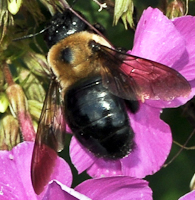|
Does
it look like a bumble bee? Does it suddenly disappear
under a ledge or eave? Is there a perfectly round hole
near where it disappeared? Is the little hole in the
bottom side of the trim or structure board? Is the wood
bare, need painting, or stained wood? Is the wood cedar,
redwood or some other soft wood? If the answer to most
or all of these questions is yes!, then you probably are providing a home for a
carpenter
bee.

 The most common group of carpenter bees in this part of the country
resembles bumble bees. They are about the same size, have yellow markings
on the thorax (middle part of body) like the bumble bee, but are much darker
in color and the abdomen mostly black and bald; gives the appearance of
being shiny.
The burrow opening is a round hole in the wood about a 1/2 inches in
diameter. The precision of the cut will make you think it was done with
a drill. When the female is actively constructing the burrow and brood
chambers, you should be able to observe a small pile of discarded wood
shavings directly below the single entrance/exit hole.
After a carpenter bee female has set up housekeeping and after the young-of-the-year
become adults the outside of the burrow hole will show brown and/or yellow
staining. This is bee excrement.
 Structural wood that is the most inviting to a female carpenter
bee is either a horizontal or slanting board of soft wood (e.g., cedar
or redwood) with little or no paint. If you have siding, eaves, wooden
shakes, porch ceilings, windowsills or doors that have these characteristics
you are inviting a visit from a carpenter bee each spring.
The physical damage is a vertical round shaft with 2-6 horizontal brood
chambers connected to the entrance/exit burrow. Depth of the main burrow
will be about 3-6 inches. Besides constructing new nesting sites, female
carpenter bees will also use galleries from previous years.
Even though carpenter bees are equipped with a stinger they are quite
docile. About the only thing that will provoke stinging behavior is being
handled and petted.
 If you have carpenter bees burrowing into a wood surface of your home
dust or spray burrow entrances to nest with an insecticide dust labeled for this
problem.
It is best to treat nests when you first notice activity around the
hole. The insecticide dust will easily kill both the adults and "uncapped" brood
chambers.
You may need to treat again in August when new adults emerge and become
active. In the fall, fill the burrow holes and paint or varnish the entire
wood. |



